MAX4370ESA+ Maxim Integrated Products, MAX4370ESA+ Datasheet - Page 14

MAX4370ESA+
Manufacturer Part Number
MAX4370ESA+
Description
IC CNTRLR HOT-SWAP 8-SOIC
Manufacturer
Maxim Integrated Products
Type
Hot-Swap Controllerr
Datasheet
1.MAX4370ESA.pdf
(16 pages)
Specifications of MAX4370ESA+
Applications
General Purpose
Internal Switch(s)
No
Voltage - Supply
2.7 V ~ 13.2 V
Operating Temperature
-40°C ~ 85°C
Mounting Type
Surface Mount
Package / Case
8-SOIC (0.154", 3.90mm Width)
Lead Free Status / RoHS Status
Lead free / RoHS Compliant
The MAX4370 can be used on the backplane to regu-
late current upon insertion of a removable card. This
allows multiple cards with different input capacitance to
be inserted into the same slot even if the card doesn’t
have on-board hot-swap protection.
The MAX4370 current-limiting feature is active during
the start-up period set by CTIM. The start-up period
can be triggered if V
trace on the card. Once t
the load capacitance has to be charged or a fault con-
dition is detected. To ensure start-up with a fixed CTIM,
t
charge the board capacitance. The maximum load
capacitance is calculated as follows:
The voltage at V
inrush and fault conditions. When a short condition
occurs on the board, the fault current can be higher
than the fast comparator current limit. The gate voltage
is discharged immediately, but note that the MOSFET is
not completely off until V
power supply collapses below UVLO, the MAX4370 will
force the device to restart once the supply has recov-
ered. The main system power supply must be able to
deliver this fault current without excessive voltage drop.
The MOSFET is turned off in a very short time; there-
fore, the resulting di/dt can be considerable. The back-
plane delivering the power to the external card must
have a fairly low inductance to limit the voltage tran
sients caused by the removal of a fault.
During normal operation, the MOSFET dissipates little
power; it is fully turned on and its R
The power dissipated in normal operation is P
(I
dissipated during the turn-on and turn-off transients.
The design must take into consideration the worst-case
scenario of a continuous short-circuit fault present on
the board. Two cases must be considered:
1) The single turn-on with the device latched after a
2) An external circuit forces a continuous automatic
MOSFET manufacturers typically include the package
normalized transient thermal resistance (r
r
the retry duty cycle (d = t
Current-Regulating Hot-Swap Controller with
DualSpeed/BiLevel Fault Protection
14
START
LOAD) 2
JC
fault.
retry after the fault.
(t)), which is determined by the start-up time and
______________________________________________________________________________________
Using the MAX4370 on the Backplane
has to be longer than the time required to
· R
C
DS(ON)
BOARD
MOSFET Thermal Considerations
IN
. A considerable amount of power is
< t
must be above the UVLO during
IN
START
is connected to ON through a
START
GS
START
< V
· I
FAST,SET
has expired (timed out),
/ t
TH
Input Transients
RETRY
. If the main system
DS(ON)
/ V
). The following
IN
is minimal.
JA
(t) or
D
=
-
equation is used to calculate the required transient
thermal resistance:
where P
R
mined with a continuous load and by the layout or
heatsink.
To take full advantage of the switch response time to an
output fault condition, it is important to keep all traces
as short as possible and to maximize the high-current
trace dimensions to reduce the effect of undesirable
parasitic inductance. Place the MAX4370 close to the
card’s connector. Use a ground plane to minimize its
impedance and inductance.
Minimize the current-sense resistor trace length
(<10mm), and ensure accurate current sensing with
Kelvin connections (Figure 12).
When the output is short circuited, the voltage drop
across the external MOSFET becomes large. Hence,
the power dissipation across the switch increases, as
does the die temperature. An efficient way to achieve
good power dissipation on a surface-mount package is
to lay out two copper pads directly under the package
on both sides of the board. Connect the two pads to
the ground plane through vias, and use enlarged cop-
per mounting pads on the top side of the board.
Figure 11. Using the MAX4370 on the Backplane
V
JA
IN
(t) / r
DMAX
V
CTIM
IN
R
JA
JA
MAX4370
(t) = V
(t). R
VSEN
(t) = (T
IN
JA
GATE
ON
J,MAX
· I
is the thermal resistance deter-
FAULT
BACKPLANE
Layout Considerations
- T
and the resulting R
A
) / P
REMOVABLE CARD
WITH NO HOT-INSERTION
PROTECTION
D,MAX
(t)
C
BOARD
V
OUT
JA
=







